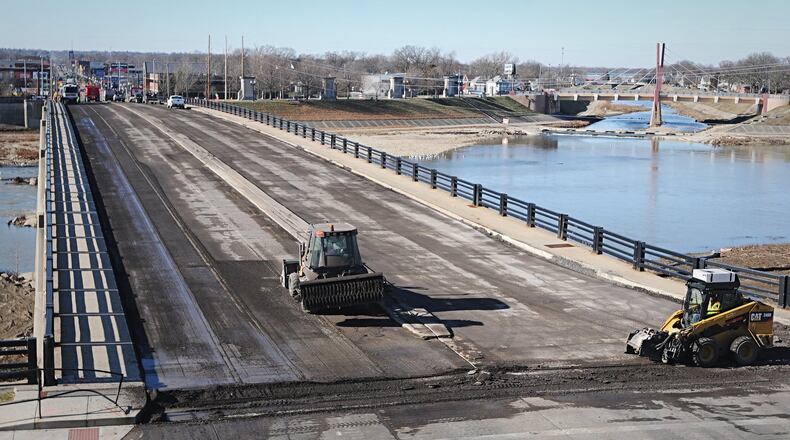Pick your preferred pronunciation - Donald Trump or Bernie Sanders-style - of “billions and billions” and read aloud. But remember the scale of these matters as you interpret the staggering figures: A person can count to a million in under two weeks, but it would take more than 30 years to count to one billion.
If the bill passes, many taxpayers will see one-time payments in their bank accounts as soon as early April. The move is meant to ease the financial burden many families currently have and encourage spending to bolster the economy. Not everyone will receive the same amounts. Individuals who make $75,000 or less and married couples making up to $150,000 will receive $1,200 per adult and $500 per child. Those whose incomes are higher will see smaller checks. Individuals who make $99,000 or more and couples who make $198,000 or more would not receive a check. Income levels will be based on reported 2018 taxes.
CORONARIVUS: Complete coverage from the Dayton Daily News
$139 BILLION TO STATE AND LOCAL GOVERNMENTS
The bill stipulates that within 30 days of enactment the Treasury secretary shall distribute funds to state and local governments. Amounts going to each of the 50 states will be determined in proportion to the population, with no state government receiving less than $1.25 billion. Eligible local governments are defined as any governing body below the state level having more than 500,000 people under its purview. The inspector general of the Treasury is charged with conducting oversight of receipt and distribution.
$400 MILLION FOR STATES TO ADJUST ELECTIONS
It’s a drop in the ballot box bucket compared with estimates being bandied about. The Brennan Center for Justice estimates $2 billion is necessary for states to accommodate mail-in ballots and other measures that divert action from traditional precinct polling places. House Democrats initially proposed $4 billion in election assistance, while Senate Republicans proposed $140 million.
AIRLINES: $29 BILLION IN LOANS, $29 BILLION IN GRANTS
In the end, the airlines got what they wanted. Maybe especially Boeing. The company’s stocks jumped more than 30% in midday trading and stayed there as news circulated that the air carrier was poised to receive what some senators lambasted as a bailout. The bill designates $17 billion for businesses “critical to maintaining national security.” While no specific company is named, people familiar with the negotiations say it is meant for Boeing, a major U.S. defense contractor with lingering 737 Max problems in addition to the coronavirus struggles.
$100 BILLION TO HOSPITALS AND HEALTH CARE PROVIDERS
Nearly a third of the entire stimulus package will provide reimbursements and supplement lost revenue to hospitals. Another $27 billion will funnel to research and development around the vaccine, supervised by the Biomedical Advanced Research and Development Authority of the Health and Human Services Department. However, more than half of that might go to replenishing national stockpiles of medical supplies, drugs and protective equipment.
RELATED: Coronavirus stay-at-home order: What businesses are considered essential?
$45 BILLION FOR FEMA
The Federal Emergency Management Agency Disaster Relief Fund will receive $45 billion. The funds are intended to help state and local efforts, including medical response and purchasing protective equipment. The breakdown includes: $200 million for shelter, food and services $100 million in grants to firefighters for protective equipment, supplies and reimbursements$100 million for enhanced sanitation at airport security checkpoints and other airport costs.
$14 BILLION FOR FARMERS
The stimulus package gives the Agriculture Department up to $14 billion for the Commodity Credit Corp. to shore up losses. The bill would also provide USDA $9.5 billion to combat economic effects of a COVID-19 downturn as states and localities close farmers markets and restaurants.
$10.5 BILLION FOR THE PENTAGON
The Defense Department funds being allocated split into six categories: personnel, operations and maintenance, purchasing, investment, health care and insurance coverage. The biggest slice of the pie goes to the Defense Health Program, which provides medical care to personnel, including active-duty troops and dependents. Another $1.1 billion is set aside for Tricare, the insurance program that oversees benefits for those people.
$950 MILLION TO PRISONS
Yes, $950 million is a lot of money. But consider this: 0.7% of America is incarcerated, while the amount of money going to the prison system is less than 0.3% of the stimulus package released so far. Nevertheless, $100 million will go to correctional officer overtime, personal protective equipment and supplies, and inmate medical care and supplies, according to a Republican summary of the bill. Another $850 million is designated for state and local law enforcement and jails through a grant program.
$93M FOR LEGISLATORS TO LEGISLATE
Sanitizing the Capitol costs money, and so does shifting to remote work. So lawmakers are giving Legislative Branch operations $93 million.
$13.50 PER PROOF GALLON
That’s right - no million, no billion, just dollars and cents. As it stands, the current bill would waive federal excise tax paid by distillers on alcohol that they use to make hand sanitizer, according to a draft of the legislation circulating Wednesday.
About the Author
